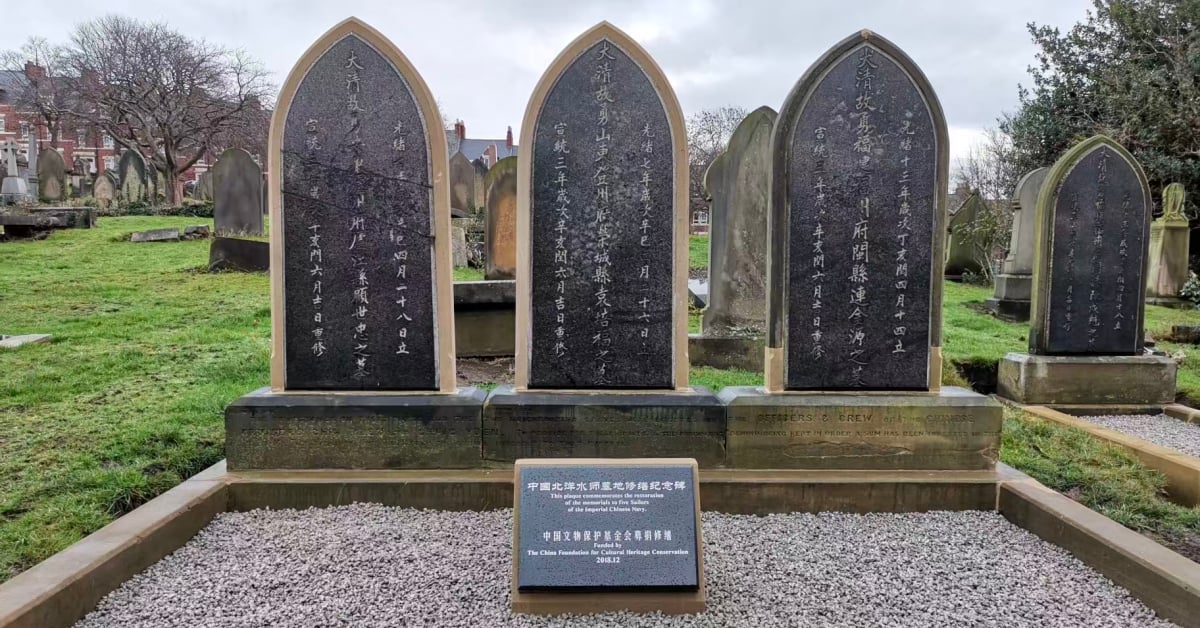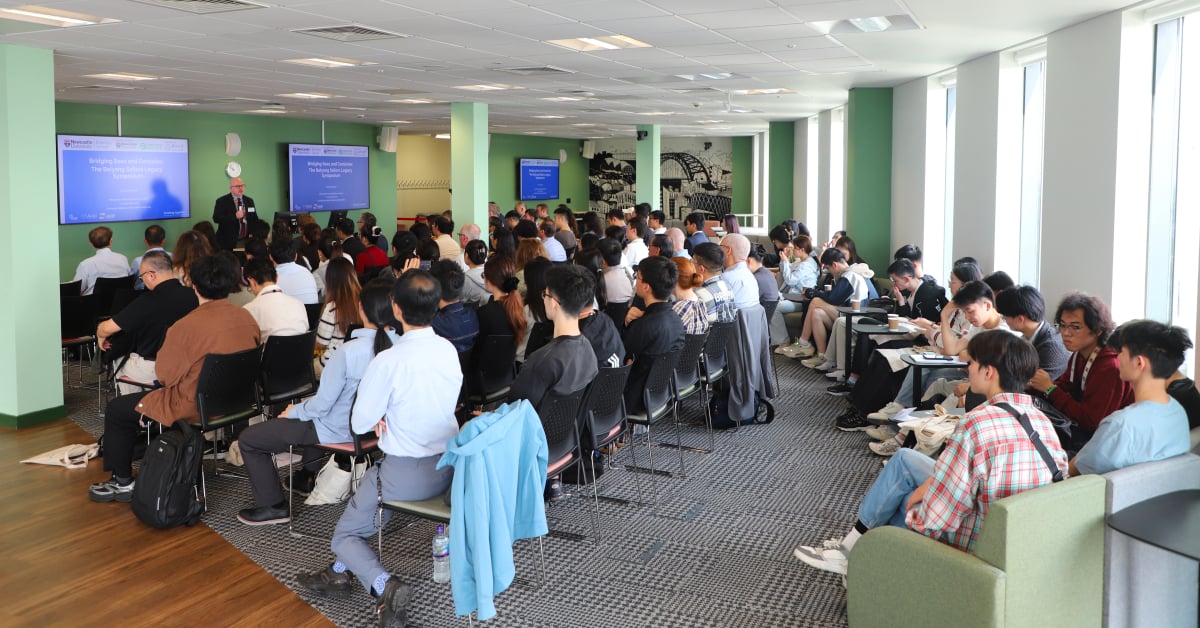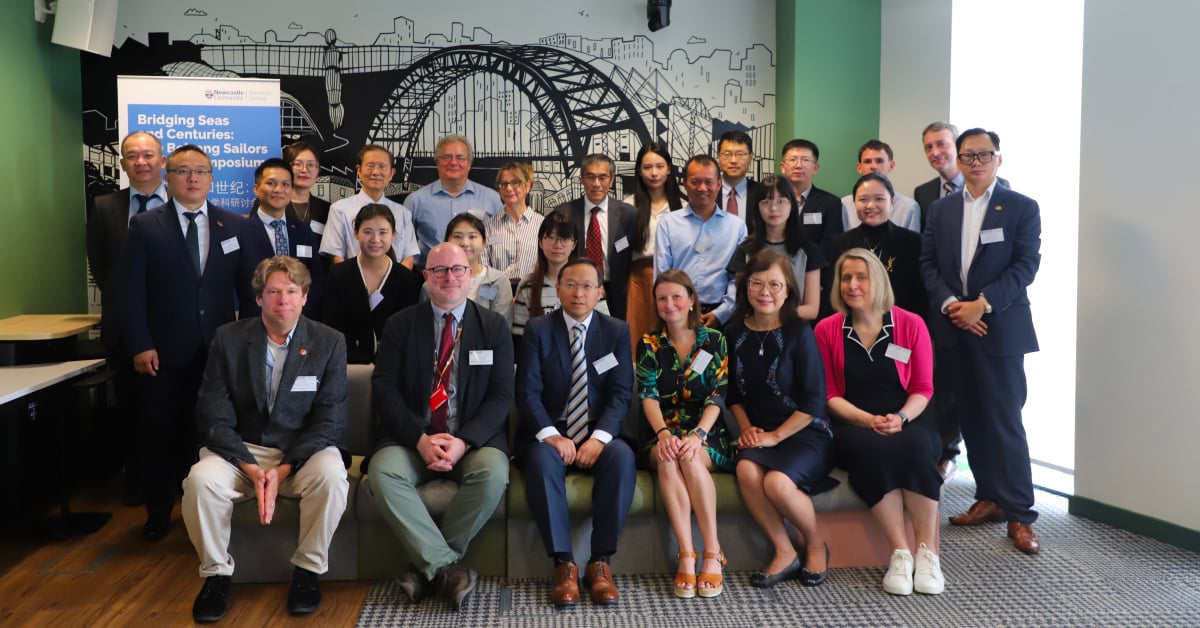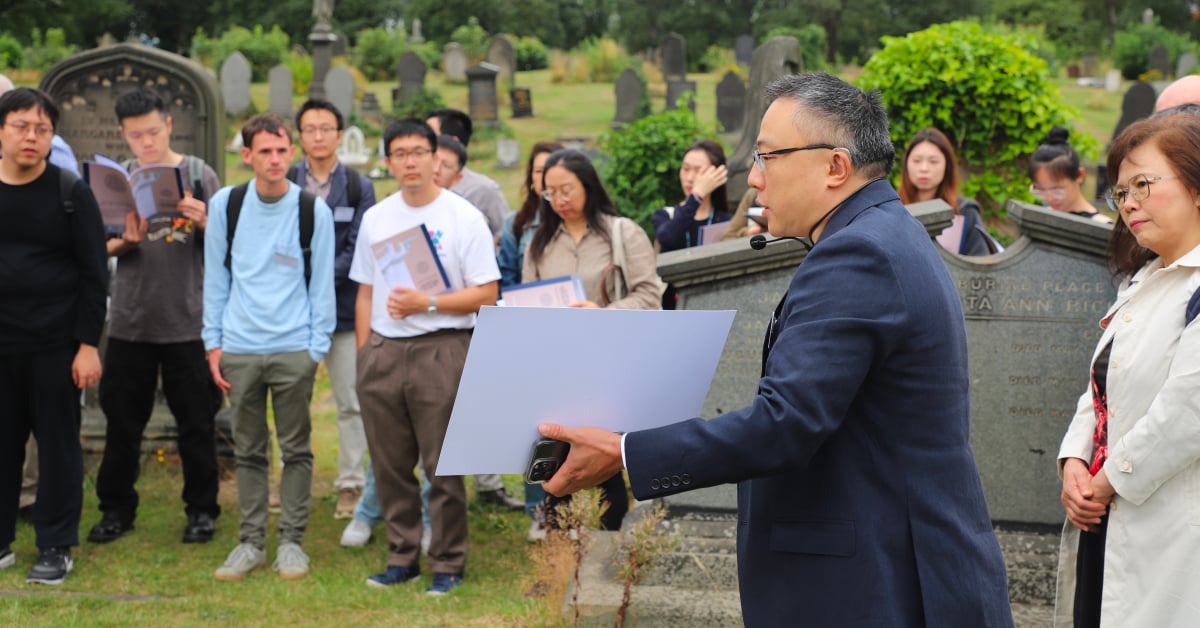Bridging seas and centuries: remembering the Beiyang sailors in Newcastle
27 August 2025 | By: Dr Yin Liang | 5 min read
How do six nineteenth century gravestones in a Newcastle upon Tyne cemetery bring together two nations?
Here, Dr Yin Liang – Lecturer in Human Resource Management – writes about how the legacy left by six Chinese sailors who never made the journey home reveals that their story isn’t a closed chapter after all.
Contents:
- The story of the Beiyang sailors
- Why the symposium matters
- Building bridges with memory
- Why now? History as a call to responsibility
- From history to future action
- Legacy and impact
The story of the Beiyang sailors
In the quiet grounds of St. John’s Cemetery in Elswick, Newcastle upon Tyne, lie six gravestones with inscriptions in Chinese, marking the final resting place of sailors from the Beiyang Fleet.
More than a century ago, these young men journeyed from China to Newcastle as part of the Qing Dynasty’s modernisation efforts, collecting newly built warships from the renowned Armstrong Shipyard on the River Tyne. The project symbolised a bold, outward-looking moment in Chinese naval history – and a surprising, enduring connection with a North East city shaped by shipbuilding and global trade.
While their comrades returned to China, these six sailors – Yuan Peifu, Gu Shizhong, Lian Jinyuan, Chen Shoufu, Chen Chengkui, and Gan Zhaogong – never made the journey home. Over the decades, their graves were weathered by time, their stories nearly lost to history. The stones stood as quiet markers of a transnational past, largely unnoticed by the city beyond the cemetery walls.
The rediscovery and restoration of these graves in recent years has brought the sailors’ story back into public view. It has prompted researchers, heritage organisations, and community groups to ask bigger questions:
- How do we remember maritime legacies across borders?
- Who decides what gets preserved, and why?
- And how can universities act as convenors — connecting scholarship with local communities to care for fragile sites of memory?



Why the symposium matters
It was against this backdrop that the Bridging Seas and Centuries: Beiyang Sailors Legacy Symposium was held at Newcastle University Business School on 21–22 July 2025.
Organised in collaboration with the Confucius Institute at Newcastle University, the symposium brought together heritage professionals, academics, community leaders, and policymakers from both China and the UK to explore how maritime legacies are remembered, governed, and revitalised in changing cultural and geopolitical contexts.
This symposium was more than an academic gathering – it was a bridge between China and the UK, across time, disciplines and sectors.

The Bridging Seas and Centuries: Beiyang Sailors Legacy Symposium at Newcastle University Business School.
The opening ceremony welcomed high profile guests from both nations, including Consul General Tang Rui of the People’s Republic of China in Manchester, Jennifer Hartley MBE, Assistant Director of Capital Investment and Growth at Newcastle City Council, and Professor Christopher Whitehead, Interim Pro-Vice-Chancellor for Global at Newcastle University.
All emphasised the importance of the Beiyang Fleet’s legacy in understanding Sino-British historical connections, promoting intercultural understanding, and advancing collaboration on heritage protection. Their presence signalled institutional support across diplomacy, local government, and higher education – crucial for translating ideas into action.
Building bridges with memory
The event was more than a historical reflection – it was a working dialogue.
Across conversations, participants examined how archives, museums, local authorities, and community organisations can co-produce memory; how policy and governance frameworks can better safeguard contested or transnational heritage; and how digital tools might help preserve fragile records while making them accessible to broader audiences.
By revisiting the shared maritime cultural heritage of China and the UK, we not only reconnected with the legacy of the Beiyang sailors, but also created a platform for dialogue among academics, heritage professionals, policy makers, and community stakeholders on how history, memory and management intersect in shaping contemporary intercultural cooperation.
Keynote speakers, including Professor Jiande Lu from Chinese Academy of Social Sciences and Xiamen University, Dr Siyu Wang from Peking University, Dr Jeremy Aroles from the University of York, and Professor Zhibin Lin from Durham University, explored themes from cultural memory and archaeology to organisational management and heritage tourism. Their talks set out a shared ambition: to treat the Beiyang sailors’ story not as a closed chapter, but as a living bridge between places, institutions, and communities.

Attendees of the Bridging Seas and Centuries: Beiyang Sailors Legacy Symposium at Newcastle University Business School.
Why now? History as a call to responsibility
Newcastle’s connection to the Beiyang Fleet runs deeper than shipbuilding contracts. Archival traces and community memories reveal a pattern of visits and exchanges that extended well into the early twentieth century.
In 1911, visiting Chinese naval captains repaired their comrades’ graves – possibly the earliest documented grave restoration associated with the Beiyang Fleet in the UK. More recently, a community-led effort in 2016 initiated a major repair of the stones, restoring dignity to the sailors and reigniting interest in the site.
The 2024 identification of the sixth grave, belonging to Gan Zhaogong, marked a turning point. The cemetery was no longer simply a historical curiosity but a catalyst for international collaboration on heritage care.
This is why the symposium matters now. Heritage work tends to be episodic – rising to public attention and then receding. The Beiyang graves invite a different approach: a sustained, cross-sector partnership that blends scholarship with stewardship, civic pride with international exchange. By convening researchers, city representatives, museum practitioners, and community leaders, the symposium transformed a rediscovered story into a shared responsibility.
From history to future action
The symposium did not end at the venue. Participants visited St. John’s Cemetery and the Discovery Museum, connecting scholarship to physical sites of memory.
Seeing the gravestones – and learning about the sailors’ journeys – shifted the tone of the conversation from primarily academic and research discussions to a shared focus on practical stewardship.
In a discussion led by Yongqiang Qi, Head of Beiyang Fleet Heritage Foundation UK, participants – including experts, scholars, and leaders from various departments and organisations – explored a range of possible next steps for collaboration. Ideas included the creation of a permanent commemorative space at St. John’s Cemetery, potentially incorporating wayfinding, seating, or an interpretive plaque co-designed with community groups, the City Council, and heritage bodies to support reflective visits and educational activities.

Yongqiang Qi, Head of the Beiyang Fleet Heritage Foundation UK, sharing the story of the gravestone restorations at St. John’s Cemetery.
Another possibility discussed was developing a bilingual digital archive of documents, photographs, and oral histories relating to the Beiyang Fleet graves and Newcastle’s shipbuilding heritage, supported by clear governance and preservation frameworks.
Participants also considered co-curated exhibitions and learning materials in partnership with the Discovery Museum and educational institutions, placing the story of the Beiyang sailors within the wider context of Sino–British maritime history and make it accessible to schools, universities, and public audiences.
There was also interest in establishing an annual remembrance and community programme with memorial events, workshops, talks, and guided walks to bring local residents, students, and international visitors into the story of the site. Finally, participants noted the potential for research and training pathways for students, through interdisciplinary projects and placements in heritage management, translation, public history, and digital humanities – offering valuable hands-on experience in community-engaged heritage work.

Symposium attendees at the Discovery Museum in Newcastle.
Legacy and impact
The Beiyang sailors’ story is one of transnational ties, resilience, and remembrance. It speaks to Newcastle’s maritime heritage, China’s journey towards modernisation, and the enduring bonds between two nations.
But memory work matters most when it changes what we do next.
By bringing together diverse voices – from academics to local community members – the symposium created a shared vision: to protect and promote a legacy that transcends oceans and centuries. Importantly, it translated that vision into practical steps – grounded in partnership, respectful of the site, and open to the public. The presence and support of senior guests underscored that this is not a niche academic project but a civic and international endeavour, with room for collaboration across sectors.
If you are interested in contributing ideas or getting involved in community efforts to further protect this shared heritage between China and the UK – or if you are a researcher or student keen to support the digital archiving initiative or the creation of bilingual resources – please contact Dr Yin Liang, symposium lead at Newcastle University Business School.
Together, we can ensure that a quiet corner of a Newcastle cemetery continues to bridge seas and centuries – keeping faith with six sailors whose story still has the power to connect us today.
You might also like
- find out more about blog author and symposium lead Dr Yin Liang, lecturer in Human Resource Management at Newcastle University
- read the press release: Chinese history of Newcastle graveyard explored
- discover the work of Beiyang Fleet Heritage Foundation UK
- find out more about The Confucius Institute, a partnership between Newcastle University and Xiamen University of China
- explore more about how Newcastle University works as a values-led global university and hub for international engagement
